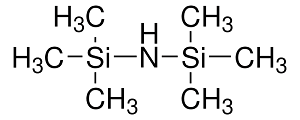1,1,3,3-Hexamethyldisilazane

Product Description
1,1,3,3-Hexamethyldisilazane is a chemical compound with various industrial applications.
Product:
1,1,3,3-Hexamethyldisilazane
CAS:
999-97-3
Synonym:
Hexamethyldisilazane; Bis(trimethylsilyl)amine
Structure:

Typical Characteristics
Appearance
Colorless liquid
Boiling point
125 °C
Density
0.7741 g/cm3
Flash Point
27 °C
Molecular Weight
161.39
Odor
Ammonia-like odor
Purity
≥99%
Refractive index
1.407
Uses, Applications & Markets
Key applications
get a quote
We Offer 1,1,3,3-Hexamethyldisilazane
in various grades
A few of the grades available are listed below:



1,1,3,3-Hexamethyldisilazane used in many
industry applications
1,1,3,3-Hexamethyldisilazane is a chemical compound with various industrial applications. Here are some of its main uses:
- Silylation Agent: 1,1,3,3-Hexamethyldisilazane is commonly used as a silylation reagent in organic synthesis and analytical chemistry. It reacts with hydroxyl (-OH) and amino (-NH2) functional groups to form trimethylsilyl (-Si(CH3)3) derivatives, which are volatile and more amenable to gas chromatography (GC) and mass spectrometry (MS) analysis. This silylation process helps protect sensitive functional groups, enhance compound volatility, and improve analytical detection sensitivity.
- Surface Modification: It finds applications in surface modification and functionalization processes to impart hydrophobic or oleophobic properties to various substrates, including glass, silicon, metals, and polymers. 1,1,3,3-Hexamethyldisilazane can form self-assembled monolayers (SAMs) or thin film coatings on surfaces, reducing surface energy and preventing adhesion or wetting by water, oils, and other liquids. This surface treatment is utilized in the fabrication of microfluidic devices, electronic components, and anti-fouling coatings.
- Protective Coating: This compound is employed as a coating material to provide moisture and corrosion protection to sensitive electronic components and semiconductor devices. By forming a thin, conformal layer on the surface, 1,1,3,3-hexamethyldisilazane helps prevent moisture ingress and surface oxidation, thereby improving device reliability and performance in harsh environmental conditions. It is particularly used in the semiconductor industry for passivation and protection of silicon wafers and integrated circuits.
- Adhesion Promoter: It is utilized as an adhesion promoter or coupling agent in adhesive formulations and composite materials. 1,1,3,3-Hexamethyldisilazane can enhance the adhesion between dissimilar materials by promoting interfacial bonding and improving wetting characteristics. It is commonly incorporated into epoxy, silicone, and polyurethane adhesives to enhance substrate adhesion and mechanical strength.
- Chemical Vapor Deposition (CVD): This compound is used as a precursor in chemical vapor deposition (CVD) processes for the synthesis of thin films and functional coatings. It can be vaporized and thermally decomposed to deposit silicon-containing films, such as silicon dioxide (SiO2) or silicon nitride (Si3N4), on substrate surfaces. These deposited films exhibit excellent dielectric, barrier, and passivation properties, making them suitable for microelectronic and optical applications.
- Hydrophobization Agent: 1,1,3,3-Hexamethyldisilazane is employed in the hydrophobization of porous materials, such as silica gel, glass wool, and ceramic membranes. By treating the surface with hexamethyldisilazane, the pore walls become coated with hydrophobic methyl groups, resulting in reduced water uptake and improved resistance to fouling or clogging by aqueous solutions. This hydrophobic modification is beneficial in separation processes, chromatography, and water treatment applications.